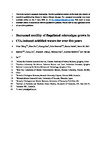Decreased motility of flagellated microalgae long-term acclimated to CO2-induced acidified waters
| dc.contributor.author | Wang, Y | |
| dc.contributor.author | Fan, X | |
| dc.contributor.author | Gao, G | |
| dc.contributor.author | Beardall, J | |
| dc.contributor.author | Inaba, K | |
| dc.contributor.author | Hall-Spencer, Jason | |
| dc.contributor.author | Xu, D | |
| dc.contributor.author | Zhang, X | |
| dc.contributor.author | Han, W | |
| dc.contributor.author | McMinn, A | |
| dc.contributor.author | Ye, N | |
| dc.date.accessioned | 2020-09-28T15:45:52Z | |
| dc.date.available | 2020-09-28T15:45:52Z | |
| dc.date.issued | 2020-06-01 | |
| dc.identifier.issn | 1758-678X | |
| dc.identifier.issn | 1758-6798 | |
| dc.identifier.uri | http://hdl.handle.net/10026.1/16437 | |
| dc.description.abstract |
Motility plays a critical role in algal survival and reproduction, with implications for aquatic ecosystem stability. However, the effect of elevated CO2 on marine, brackish and freshwater algal motility is unclear. Here we show, using laboratory microscale and field mesoscale experiments, that three typical phytoplankton species had decreased motility with increased CO2. Polar marine Microglena sp., euryhaline Dunaliella salina and freshwater Chlamydomonas reinhardtii were grown under different CO2 concentrations for 5 years. Long-term acclimated Microglena sp. showed substantially decreased photo-responses in all treatments, with a photophobic reaction affecting intracellular calcium concentration. Genes regulating flagellar movement were significantly downregulated (P < 0.05), alongside a significant increase in gene expression for flagellar shedding (P < 0.05). D. salina and C. reinhardtii showed similar results, suggesting that motility changes are common across flagellated species. As the flagella structure and bending mechanism are conserved from unicellular organisms to vertebrates, these results suggest that increasing surface water CO2 concentrations may affect flagellated cells from algae to fish. | |
| dc.format.extent | 561-567 | |
| dc.language | en | |
| dc.language.iso | en | |
| dc.publisher | Nature Research | |
| dc.subject | Genetics | |
| dc.title | Decreased motility of flagellated microalgae long-term acclimated to CO2-induced acidified waters | |
| dc.type | journal-article | |
| dc.type | Journal Article | |
| plymouth.author-url | https://www.webofscience.com/api/gateway?GWVersion=2&SrcApp=PARTNER_APP&SrcAuth=LinksAMR&KeyUT=WOS:000537042800003&DestLinkType=FullRecord&DestApp=ALL_WOS&UsrCustomerID=11bb513d99f797142bcfeffcc58ea008 | |
| plymouth.issue | 6 | |
| plymouth.volume | 10 | |
| plymouth.publication-status | Published | |
| plymouth.journal | Nature Climate Change | |
| dc.identifier.doi | 10.1038/s41558-020-0776-2 | |
| plymouth.organisational-group | /Plymouth | |
| plymouth.organisational-group | /Plymouth/Faculty of Science and Engineering | |
| plymouth.organisational-group | /Plymouth/Faculty of Science and Engineering/School of Biological and Marine Sciences | |
| plymouth.organisational-group | /Plymouth/PRIMaRE Publications | |
| plymouth.organisational-group | /Plymouth/REF 2021 Researchers by UoA | |
| plymouth.organisational-group | /Plymouth/REF 2021 Researchers by UoA/UoA07 Earth Systems and Environmental Sciences | |
| plymouth.organisational-group | /Plymouth/Research Groups | |
| plymouth.organisational-group | /Plymouth/Research Groups/Marine Institute | |
| plymouth.organisational-group | /Plymouth/Users by role | |
| plymouth.organisational-group | /Plymouth/Users by role/Academics | |
| dcterms.dateAccepted | 2020-04-09 | |
| dc.rights.embargodate | 2020-12-1 | |
| dc.identifier.eissn | 1758-6798 | |
| dc.rights.embargoperiod | Not known | |
| rioxxterms.versionofrecord | 10.1038/s41558-020-0776-2 | |
| rioxxterms.licenseref.uri | http://www.rioxx.net/licenses/all-rights-reserved | |
| rioxxterms.licenseref.startdate | 2020-06-01 | |
| rioxxterms.type | Journal Article/Review |


